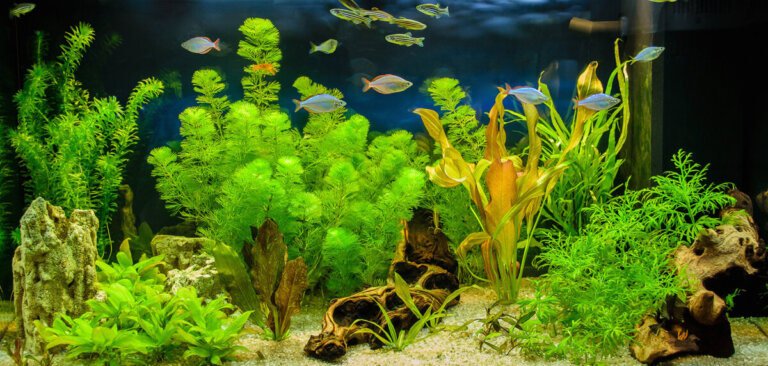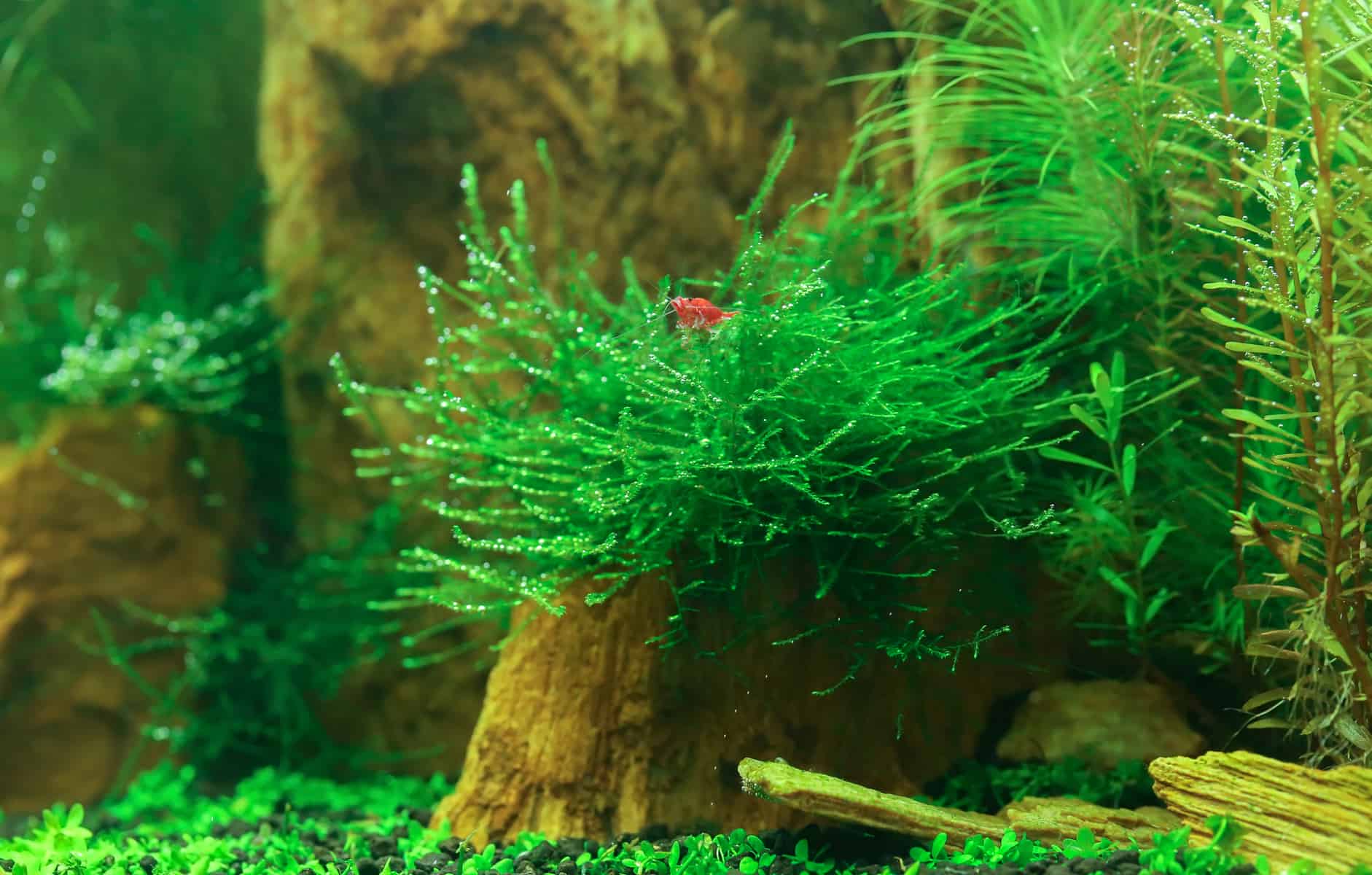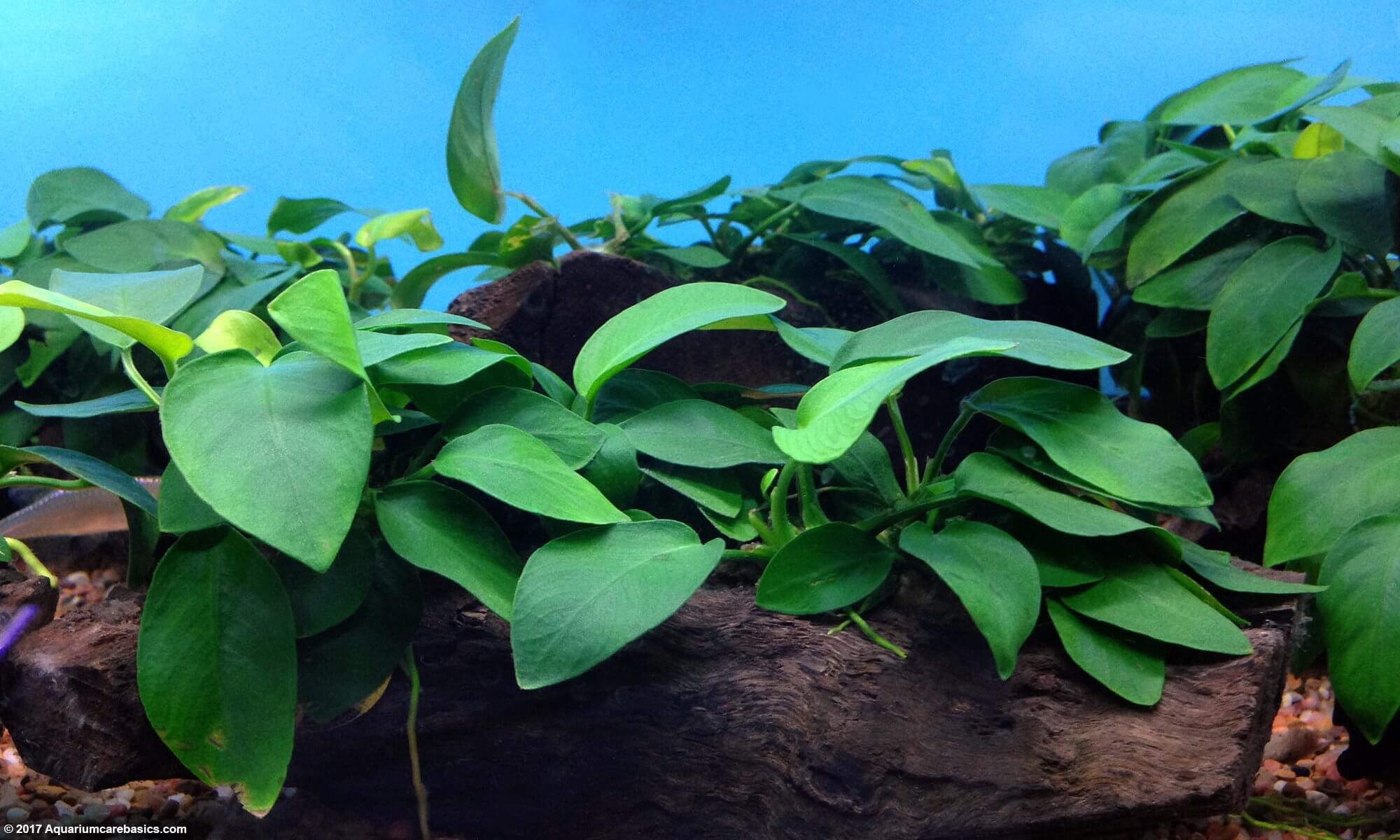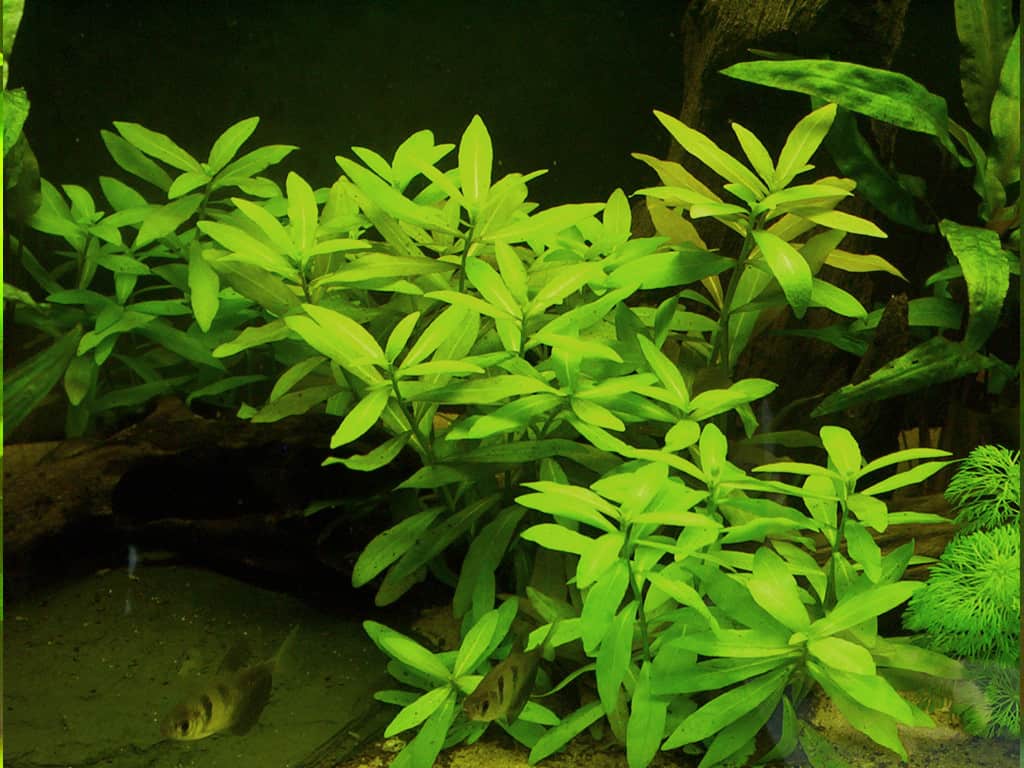5 Aquarium Plants for Beginners: Features and Care

Creating an aquarium is a fascinating way to immerse yourself in the aquatic world and enjoy the beauty of underwater life. With that in mind, it’s essential to get started with plants that are easy to care for and provide a healthy environment for your fish. Here are five aquarium plants ideal for beginners, along with their characteristics and basic care requirements.
1. Java moss (Taxiphyllum barbieri)

Java moss is one of the most versatile aquarium plants. Its delicate appearance and ease of care make it a popular choice for beginners and experienced hobbyists alike.
Native to Southeast Asia, this plant’s scientific name is Taxiphyllum barbieri, and it belongs to the family Hypnaceae.
Java moss: Features and care requirements
This plant is characterized by tiny, scale-like leaves that grow on long, slender stems. It’s an ideal choice for creating natural waterscapes because of its unique appearance and ability to adhere to various substrates:
- Rocks
- Wood
- Decorations
As it grows, it forms a sort of carpet or mantle on the surfaces to which it’s anchored. Also, it provides shelter and a spawning platform for smaller fish.
In addition, it’s known for its resilience and ability to adapt to a variety of aquatic conditions. It doesn’t require intense lighting, which makes it suitable for aquariums with varying light levels.
It can thrive in waters with varying degrees of hardness and pH, making it an excellent choice for community tanks with a variety of species.
One of the most notable advantages of Java moss is its ability to purify water by absorbing excess nutrients. This can help maintain a balance in the aquarium and reduce unwanted algae growth.
Planting and maintenance
The most common way to plant Java moss is to anchor it to rocks, wood, or other decorative surfaces in the aquarium. You can use fishing line or aquarium mesh to hold it in place until its roots naturally attach. Avoid burying the moss in the substrate, as this can block its growth and affect its health.
This plant is slow-growing, so it doesn’t require frequent pruning.
However, you can trim back any parts that become too long or dense to keep its appearance tidy and prevent it from overshading the plants in the aquarium.
Whether you want to create a natural habitat or add a touch of life to your aquarium, Java moss will meet your expectations and provide you with a beautiful aquatic environment.
2. Anubias

Anubias are a group of aquatic plants that offer a unique combination of beauty and hardiness. Native to Africa and parts of Asia, the scientific name for these plants is Anubias spp and they belong to the family Araceae.
Features
Anubias leaves are thick and dark green in color. These features give them a sturdy and hardy appearance. They come in a variety of shapes and sizes, from small, pointed leaves to larger, rounded leaves. Within the range of varieties of this plant, the following can be highlighted:
- Anubias barteri nana
- Anubias barteri barteri barteri
- Anubias barteri coffeefolia
This diversity allows aquarists to choose the option that best suits their design. In addition, they share certain characteristics, such as those listed below:
- Growth rate: Slow.
- Optimum parameters: pH 5.5 to 8.5 and gH 6 to 12.
- Maximum height: 1 foot.
- Aquarium zone: The back or middle part of the aquarium.
A distinctive feature of anubias is that they grow from a rhizome, a horizontal stem that produces roots and leaves. If you want to include this species in your aquarium, you should take into account its care instructions.
Planting and maintenance
When anchoring anubias, avoid burying the rhizome in the substrate. You can use fishing line or aquarium mesh to secure them to the desired surfaces. Over time, the roots will cling and begin to attach naturally.
Maintenance is simple; you don’t need to prune them frequently, which minimizes intervention in your aquarium. However, if old or damaged leaves need to be trimmed, be sure to do so carefully so as not to damage the rhizome.
One of the reasons anubias are ideal for beginners is their adaptability. They tolerate a variety of water conditions, making them suitable for both freshwater and saltwater aquariums . Although they’re not very demanding when it comes to lighting, a moderate light level is sufficient for their growth.
Benefits of anubias that few know about
In addition to their aesthetic appeal, anubias also offer functional benefits. Some of these are as follows:
- Prevent excessive algae growth.
- Help oxygenate the water by releasing oxygen during the photosynthesis process.
- Helping to maintain a balance in the aquarium ecosystem, thanks to their slow growth and ability to absorb nutrients.
3. Vallisnerias

Vallisneria is a genus of aquatic plants popular in the aquarium world, due to its attractiveness and its ability to oxygenate and beautify aquariums. It belongs to the Hydrocharitaceae family and is found naturally in aquatic habitats in tropical and temperate regions throughout the world:
- Rivers
- Lakes
- Ponds
Characteristics
It’s known for its ribbon-like leaves that can grow to considerable length, depending on the type of Vallisneria. Some species have leaves up to several yards long.
These leaves emerge from a rosette at the base of the plant and float to the surface of the water. The plant also produces stems with small white or yellow flowers that emerge above the water surface. Other known characteristics are as follows:
- Growth rate: Rapid.
- Ecosystem: Prefers slightly acidic water, but adapts to a pH between 6 and 7.5 and gH between 2 and 30 ºd.
- Maximum height: 2 feet.
- Aquarium area: Only at the bottom, because of the height of the leaves.
- Illumination: Moderate. Its growth is optimal in high illumination.
Planting and care of Vallisnerias
Planting Vallisnerias in an aquarium involves selecting healthy plants with strong roots and burying the rhizomes in the substrate, keeping the leaves above. Likewise, it’s important to ensure good lighting and trim off old leaves.
Over time, the plant will give new shoots that you can repot to expand it. Monitor its growth to avoid shading and circulation problems in the aquarium.
To ensure healthy growth of Vallisnerias in an aquarium, it’s crucial to provide it with suitable conditions. This plant prefers moderate to intense lighting, as light is essential for its photosynthesis process.
The substrate should be rich in nutrients to allow for good rooting.
Maintaining proper water quality and providing nutrient supplements, such as liquid fertilizers, will help maintain its optimal growth and coloration.
Vallisnerias can be used in both community aquariums and plant-specific aquariums. Their presence not only adds beauty to the environment but also helps create a balanced ecosystem by providing shelter and oxygen for aquatic inhabitants.
4. Microsorum pteropus

Microsorum pteropus, also known as Java fern, belongs to the family Polypodiaceae and is valued for its unique appearance and ease of care. Native to tropical regions of Asia, this plant is known for its ability to grow in both water and terrestrial environments.
Java fern characteristics
This plant has dark green, hard leaves with a unique shape that resembles a fern leaf. The leaves grow on rhizomes, and this structure allows them to anchor themselves to objects such as rocks or wood.
As it grows, Java fern can form dense tufts that add an interesting visual dimension to aquariums. In addition, these are its main traits:
- Growth rate: Slow.
- Ecosystem: pH between 5.5 and 8. gH between 4 and 20 ºd.
- Maximum height: 10 inches.
- Aquarium zone: Bottom or middle zone.
- Ideal temperature: 18 to 28 ºC.
Maintenance and care
Planting Microsorum pteropus is simple. You can attach the rhizomes to rocks or wood, by using a fishing line -for a while-, until the roots attach themselves. Some people also choose to plant it directly into the substrate and avoid burying the rhizomes.
This plant prefers moderate to low lighting and can thrive even in aquariums with less intense lighting.
Also, it is not demanding in terms of nutrients and grows best in aquariums with low to medium maintenance settings.
Keep in mind that the water should be kept in good condition. To do this, avoid extreme fluctuations in temperature and water quality.
5. Hygrophila polysperma

Hygrophila polysperma is a popular aquatic plant in aquariums because of its easy care and rapid growth. Originally from Asia, this plant belongs to the Acanthaceae family and is known as “hygrophilous”.
This plant is suitable for both beginners and more experienced aquarists. It provides a pleasing visual effect and contributes to maintaining a balance in the aquatic ecosystem by absorbing nutrients in the water.
Features of hygrophila
This plant has light green, delicate leaves, which can vary in shape, according to aquarium conditions. They are often used to add height and texture to the design, in order to create a dense and lush appearance. In addition, these are their main peculiarities:
- Growth rate: fast.
- Ecosystem: freshwater aquarium.
- Maximum height: about 20-40 centimeters, but it can grow more in ideal conditions.
- Ideal aquarium zone: bottom to middle of the aquarium.
- Ideal temperature: 71 to 82 °F.
Maintenance and care
Planting Hygrophila polysperma is simple. You can plant stem cuttings in the aquarium substrate as long as the roots are covered and the shoots are above the substrate.
In terms of care, this plant is adaptable. It prefers moderate to intense lighting for optimal growth and vivid leaf colors. It also requires nutrients in the water, so it’s important to provide liquid fertilizers or tablets in the substrate. In addition, additional carbon dioxide (CO2) can help accelerate its growth.
Given its rapid growth rate, Hygrophila polysperma may require regular pruning to prevent it from becoming too dense and shading out other vegetation. Keep an eye on its spread and adjust, according to your design preferences.
The fascinating world of aquariums
After this informative tour of the characteristics and care requirements of each of these plants, you have the makings of an attractive and healthy aquatic environment. These options are perfect for those looking to introduce vegetation into their aquariums in a simple and uncomplicated manner.
Whether it’s the versatile Java moss, hardy anubias, beautiful Vallisnerias, the distinctive Java fern, or fast-growing Hygrophila polysperma, these plants offer a wide range of options to customize and beautify your aquarium.
Creating an aquarium is a fascinating way to immerse yourself in the aquatic world and enjoy the beauty of underwater life. With that in mind, it’s essential to get started with plants that are easy to care for and provide a healthy environment for your fish. Here are five aquarium plants ideal for beginners, along with their characteristics and basic care requirements.
1. Java moss (Taxiphyllum barbieri)

Java moss is one of the most versatile aquarium plants. Its delicate appearance and ease of care make it a popular choice for beginners and experienced hobbyists alike.
Native to Southeast Asia, this plant’s scientific name is Taxiphyllum barbieri, and it belongs to the family Hypnaceae.
Java moss: Features and care requirements
This plant is characterized by tiny, scale-like leaves that grow on long, slender stems. It’s an ideal choice for creating natural waterscapes because of its unique appearance and ability to adhere to various substrates:
- Rocks
- Wood
- Decorations
As it grows, it forms a sort of carpet or mantle on the surfaces to which it’s anchored. Also, it provides shelter and a spawning platform for smaller fish.
In addition, it’s known for its resilience and ability to adapt to a variety of aquatic conditions. It doesn’t require intense lighting, which makes it suitable for aquariums with varying light levels.
It can thrive in waters with varying degrees of hardness and pH, making it an excellent choice for community tanks with a variety of species.
One of the most notable advantages of Java moss is its ability to purify water by absorbing excess nutrients. This can help maintain a balance in the aquarium and reduce unwanted algae growth.
Planting and maintenance
The most common way to plant Java moss is to anchor it to rocks, wood, or other decorative surfaces in the aquarium. You can use fishing line or aquarium mesh to hold it in place until its roots naturally attach. Avoid burying the moss in the substrate, as this can block its growth and affect its health.
This plant is slow-growing, so it doesn’t require frequent pruning.
However, you can trim back any parts that become too long or dense to keep its appearance tidy and prevent it from overshading the plants in the aquarium.
Whether you want to create a natural habitat or add a touch of life to your aquarium, Java moss will meet your expectations and provide you with a beautiful aquatic environment.
2. Anubias

Anubias are a group of aquatic plants that offer a unique combination of beauty and hardiness. Native to Africa and parts of Asia, the scientific name for these plants is Anubias spp and they belong to the family Araceae.
Features
Anubias leaves are thick and dark green in color. These features give them a sturdy and hardy appearance. They come in a variety of shapes and sizes, from small, pointed leaves to larger, rounded leaves. Within the range of varieties of this plant, the following can be highlighted:
- Anubias barteri nana
- Anubias barteri barteri barteri
- Anubias barteri coffeefolia
This diversity allows aquarists to choose the option that best suits their design. In addition, they share certain characteristics, such as those listed below:
- Growth rate: Slow.
- Optimum parameters: pH 5.5 to 8.5 and gH 6 to 12.
- Maximum height: 1 foot.
- Aquarium zone: The back or middle part of the aquarium.
A distinctive feature of anubias is that they grow from a rhizome, a horizontal stem that produces roots and leaves. If you want to include this species in your aquarium, you should take into account its care instructions.
Planting and maintenance
When anchoring anubias, avoid burying the rhizome in the substrate. You can use fishing line or aquarium mesh to secure them to the desired surfaces. Over time, the roots will cling and begin to attach naturally.
Maintenance is simple; you don’t need to prune them frequently, which minimizes intervention in your aquarium. However, if old or damaged leaves need to be trimmed, be sure to do so carefully so as not to damage the rhizome.
One of the reasons anubias are ideal for beginners is their adaptability. They tolerate a variety of water conditions, making them suitable for both freshwater and saltwater aquariums . Although they’re not very demanding when it comes to lighting, a moderate light level is sufficient for their growth.
Benefits of anubias that few know about
In addition to their aesthetic appeal, anubias also offer functional benefits. Some of these are as follows:
- Prevent excessive algae growth.
- Help oxygenate the water by releasing oxygen during the photosynthesis process.
- Helping to maintain a balance in the aquarium ecosystem, thanks to their slow growth and ability to absorb nutrients.
3. Vallisnerias

Vallisneria is a genus of aquatic plants popular in the aquarium world, due to its attractiveness and its ability to oxygenate and beautify aquariums. It belongs to the Hydrocharitaceae family and is found naturally in aquatic habitats in tropical and temperate regions throughout the world:
- Rivers
- Lakes
- Ponds
Characteristics
It’s known for its ribbon-like leaves that can grow to considerable length, depending on the type of Vallisneria. Some species have leaves up to several yards long.
These leaves emerge from a rosette at the base of the plant and float to the surface of the water. The plant also produces stems with small white or yellow flowers that emerge above the water surface. Other known characteristics are as follows:
- Growth rate: Rapid.
- Ecosystem: Prefers slightly acidic water, but adapts to a pH between 6 and 7.5 and gH between 2 and 30 ºd.
- Maximum height: 2 feet.
- Aquarium area: Only at the bottom, because of the height of the leaves.
- Illumination: Moderate. Its growth is optimal in high illumination.
Planting and care of Vallisnerias
Planting Vallisnerias in an aquarium involves selecting healthy plants with strong roots and burying the rhizomes in the substrate, keeping the leaves above. Likewise, it’s important to ensure good lighting and trim off old leaves.
Over time, the plant will give new shoots that you can repot to expand it. Monitor its growth to avoid shading and circulation problems in the aquarium.
To ensure healthy growth of Vallisnerias in an aquarium, it’s crucial to provide it with suitable conditions. This plant prefers moderate to intense lighting, as light is essential for its photosynthesis process.
The substrate should be rich in nutrients to allow for good rooting.
Maintaining proper water quality and providing nutrient supplements, such as liquid fertilizers, will help maintain its optimal growth and coloration.
Vallisnerias can be used in both community aquariums and plant-specific aquariums. Their presence not only adds beauty to the environment but also helps create a balanced ecosystem by providing shelter and oxygen for aquatic inhabitants.
4. Microsorum pteropus

Microsorum pteropus, also known as Java fern, belongs to the family Polypodiaceae and is valued for its unique appearance and ease of care. Native to tropical regions of Asia, this plant is known for its ability to grow in both water and terrestrial environments.
Java fern characteristics
This plant has dark green, hard leaves with a unique shape that resembles a fern leaf. The leaves grow on rhizomes, and this structure allows them to anchor themselves to objects such as rocks or wood.
As it grows, Java fern can form dense tufts that add an interesting visual dimension to aquariums. In addition, these are its main traits:
- Growth rate: Slow.
- Ecosystem: pH between 5.5 and 8. gH between 4 and 20 ºd.
- Maximum height: 10 inches.
- Aquarium zone: Bottom or middle zone.
- Ideal temperature: 18 to 28 ºC.
Maintenance and care
Planting Microsorum pteropus is simple. You can attach the rhizomes to rocks or wood, by using a fishing line -for a while-, until the roots attach themselves. Some people also choose to plant it directly into the substrate and avoid burying the rhizomes.
This plant prefers moderate to low lighting and can thrive even in aquariums with less intense lighting.
Also, it is not demanding in terms of nutrients and grows best in aquariums with low to medium maintenance settings.
Keep in mind that the water should be kept in good condition. To do this, avoid extreme fluctuations in temperature and water quality.
5. Hygrophila polysperma

Hygrophila polysperma is a popular aquatic plant in aquariums because of its easy care and rapid growth. Originally from Asia, this plant belongs to the Acanthaceae family and is known as “hygrophilous”.
This plant is suitable for both beginners and more experienced aquarists. It provides a pleasing visual effect and contributes to maintaining a balance in the aquatic ecosystem by absorbing nutrients in the water.
Features of hygrophila
This plant has light green, delicate leaves, which can vary in shape, according to aquarium conditions. They are often used to add height and texture to the design, in order to create a dense and lush appearance. In addition, these are their main peculiarities:
- Growth rate: fast.
- Ecosystem: freshwater aquarium.
- Maximum height: about 20-40 centimeters, but it can grow more in ideal conditions.
- Ideal aquarium zone: bottom to middle of the aquarium.
- Ideal temperature: 71 to 82 °F.
Maintenance and care
Planting Hygrophila polysperma is simple. You can plant stem cuttings in the aquarium substrate as long as the roots are covered and the shoots are above the substrate.
In terms of care, this plant is adaptable. It prefers moderate to intense lighting for optimal growth and vivid leaf colors. It also requires nutrients in the water, so it’s important to provide liquid fertilizers or tablets in the substrate. In addition, additional carbon dioxide (CO2) can help accelerate its growth.
Given its rapid growth rate, Hygrophila polysperma may require regular pruning to prevent it from becoming too dense and shading out other vegetation. Keep an eye on its spread and adjust, according to your design preferences.
The fascinating world of aquariums
After this informative tour of the characteristics and care requirements of each of these plants, you have the makings of an attractive and healthy aquatic environment. These options are perfect for those looking to introduce vegetation into their aquariums in a simple and uncomplicated manner.
Whether it’s the versatile Java moss, hardy anubias, beautiful Vallisnerias, the distinctive Java fern, or fast-growing Hygrophila polysperma, these plants offer a wide range of options to customize and beautify your aquarium.
All cited sources were thoroughly reviewed by our team to ensure their quality, reliability, currency, and validity. The bibliography of this article was considered reliable and of academic or scientific accuracy.
- Abney, C.J. (2023, 14 de abril). Plantas Marginales. Bantam.Earth. Consultado el 04 de agosto de 2023.
https://bantam.earth/marginal-plants-ponds-aquariums/ - Abney, C.J. (2023, 4 de junio). Anubias. Bantam.Earth. Consultado el 4 de agosto de 2023. https://bantam.earth/anubias-spp/
- Abney, C.J. (2023, 5 de junio). Java Moss (Taxiphyllum Barbieri). Bantam.Earth. Consultado el 11 de agosto de 2023. https://bantam.earth/java-moss-taxiphyllum-barbieri/
- Abney, C.J. (2023, 4 de junio). Java Fern (Microsorum Pteropus). Bantam.Earth. Consultado el 11 de agosto de 2023. https://bantam.earth/java-fern-microsorum-pteropus/
- Aqvium. (s.f.). Vallisneria. Consultado el 11 de agosto de 2023. https://www.aqvium.org/es/plantas-de-acuario/tipos-de-vallisneria
- Botánica Morfológica. Morfología de Plantas Vasculares. Consultado el 4 de agosto de 2023.
http://www.biologia.edu.ar/botanica/tema3/tema3_4hidrofita.htm - Lara, M. V., & Andreo, C. S. (2023). Fotosíntesis en plantas acuáticas. Mecanismos de concentración del CO2 en especies sumergidas acuáticas. Centro de Estudios Fotosintéticos y Bioquímicos (CEFOBI), Facultad de Ciencias Bioquímicas y Farmacéuticas. Consultado el 04 de agosto de 2023 de
http://listas.exa.unne.edu.ar/biologia/fisiologia.vegetal/Fotosintesisenplantasacuaticas.pdf
This text is provided for informational purposes only and does not replace consultation with a professional. If in doubt, consult your specialist.








